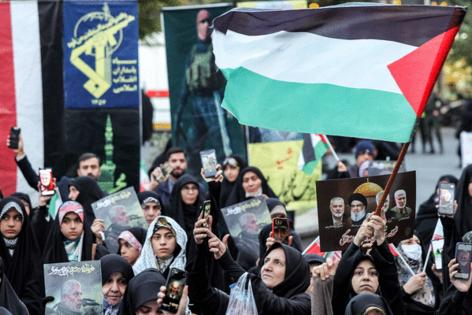Israel launches retaliatory aistrikes on Iran
Published in News & Features
TEHRAN, Iran — War in the Middle East escalated yet again early Saturday as Israel bombed targets in Iran in a spiraling pattern of attack and retaliation that has inflamed the region.
Israel said it was punishing the Islamic Republic for its missile barrage this month aimed at Israeli military installations and other sites. Those attacks came in response to Israel’s assassination of the top leader of the Iran-backed Hezbollah militia and other senior commanders in Lebanon.
It was a rare direct confrontation between two of the most heavily armed countries in the Middle East and augured ominously for easing hostilities and any future truce.
“In response to months of continuous attacks from the regime in Iran against the State of Israel — right now the Israel Defense Forces is conducting precise strikes on military targets in Iran,” the Israeli military said in a statement. “Like every other sovereign country in the world, the State of Israel has the right and the duty to respond.”
In Tehran, residents reported explosions around the capital and the nearby city of Karaj. Possible targets are missile sites controlled by the Islamic Revolutionary Guard Corps on the western edge of Tehran. Smoke could be seen wafting over the night skyline in that direction. From Tehran, smoke was also seen near the city of Shahriyar, a reputed site of underground missile storage facilities.
In Israel, Prime Minister Benjamin Netanyahu retreated to a bunker underneath the Defense Ministry in Tel Aviv, where he was joined by Defense Minister Yoav Gallant and other senior leaders. Netanyahu’s office released a photo of the group gathered around a table.
In the weeks leading up to the attack, Biden administration officials repeatedly urged Israel to avoid targeting Iran’s oil industry — lest world markets be harmed — or its nuclear power facilities.
The White House said it was notified by Israel in advance of the strikes. In a statement Friday night it said that Israel was conducting “an exercise of self-defense and in response to Iran’s ballistic missile attack against Israel on October 1.”
The strikes came a day after U.S. Secretary of State Antony J. Blinken departed the region, where he completed several days of shuttle diplomacy between Israel, Saudi Arabia and other countries in hopes of re-starting cease-fire talks for the Israel-Hamas war in the Gaza Strip.
Countries in the region had been bracing for Israel’s response to Iran after Netanyahu warned Tehran would “pay a big price” for attacking Israel.
Until now, the two countries had largely avoided direct conflict, instead waging a decades-long “shadow war” through, in Iran’s case, proxy militias, or, in Israel’s case, secret sabotage missions and assassinations.
But in a region inflamed over the last year by brutal fighting between Israel and the Palestinian Hamas militant group in the Gaza Strip, Israel and Iran moved steadily closer to actual war.
Just more than a year ago, Iran-backed Hamas invaded southern Israel, killing about 1,200 people and seizing around 250 hostages. Israel in response launched its relentless war on the Gaza Strip, and Hezbollah announced it would step up its rocketing of northern Israel in solidarity with Hamas.
Israel’s military has since killed more than 42,000 Palestinians in Gaza on its southern flank, according to the Health Ministry there. Entire neighborhoods in Gaza have been destroyed, as has much of Hamas, its leaders and infrastructure. On Oct. 18, Israel announced it had killed the senior leader of Hamas, Yahya Sinwar.
By then, Israel had shifted major military operations to its northern border with Lebanon. From inside Lebanon over the last 12 months, Hezbollah had been firing thousands of rockets and missiles into Israel, driving roughly 70,000 Israelis from their towns and killing a small number. Israel’s strikes on Lebanon had also displaced tens of thousands, until Israel’s expanded bombardments in late September.
On Sept. 30, Israel launched its first ground invasion of Lebanon in 18 years and said it was attacking Hezbollah targets. But its bombardments expanded across Lebanon, to the Bekaa Valley and even Tripoli in the north while repeatedly pounding the capital, Beirut. More than 2,000 Lebanese have been killed and 1 million displaced, according to the Lebanese health ministry.
Hezbollah is Iran’s most important proxy in the Middle East. Israel’s assassination on Sept. 27 of Hezbollah’s longtime leader, Hassan Nasrallah, triggered Iran’s retaliation four days later — a barrage of nearly 200 ballistic missiles. Backed by the U.S. and British air forces, Israel was able to intercept most of the projectiles. Still, it was only the second time Iran had attacked Israel directly, the first being in April; both times, the damage in Israel was minimal.
Israel vowed retaliation, and the region has been bracing for that ever since.
U.S.-led efforts to broker a Gaza cease-fire — aimed at freeing the remaining hostages held in Gaza, stopping the Israeli bombardment and making possible the delivery of desperately needed food and medicine — have failed thus far.
_____
(Los Angeles Times staff writer Wilkinson reported from Washington, special correspondent Mostaghim from Tehran. Staff writer Laura King in Washington contributed to this report.)
©2024 Los Angeles Times. Visit at latimes.com. Distributed by Tribune Content Agency, LLC.







Comments